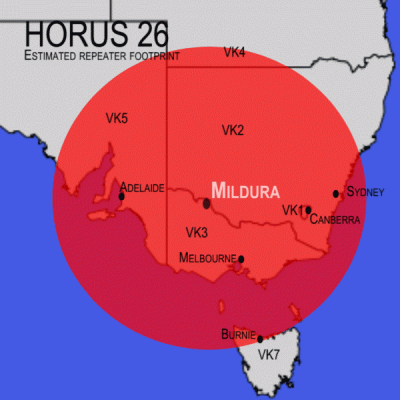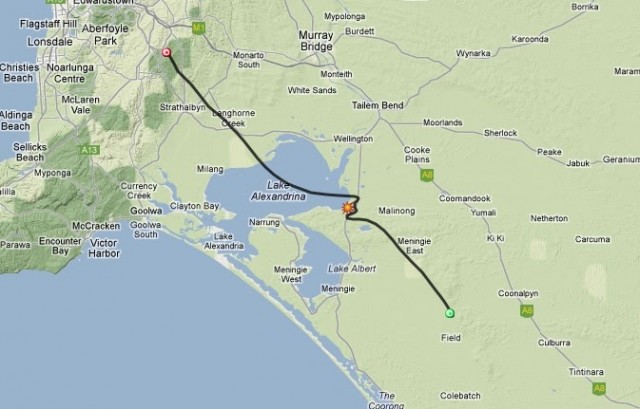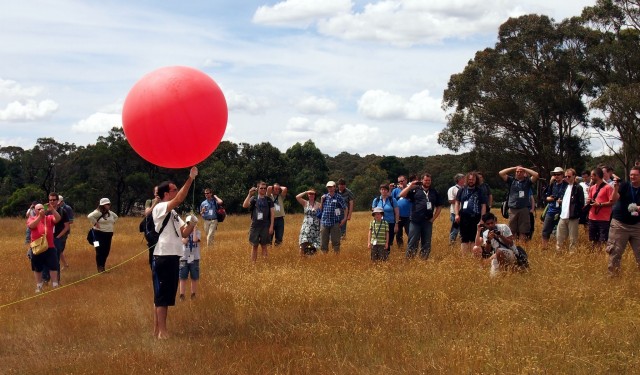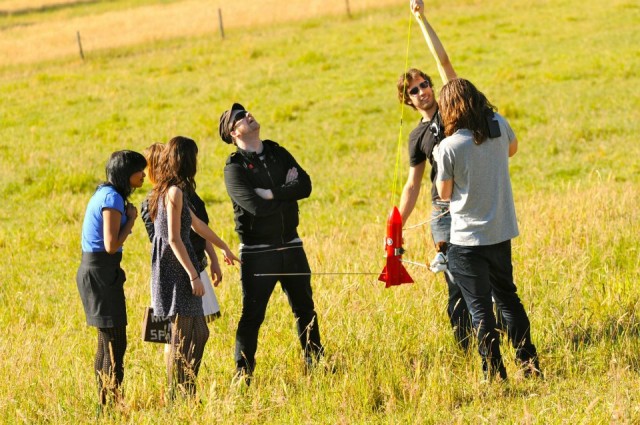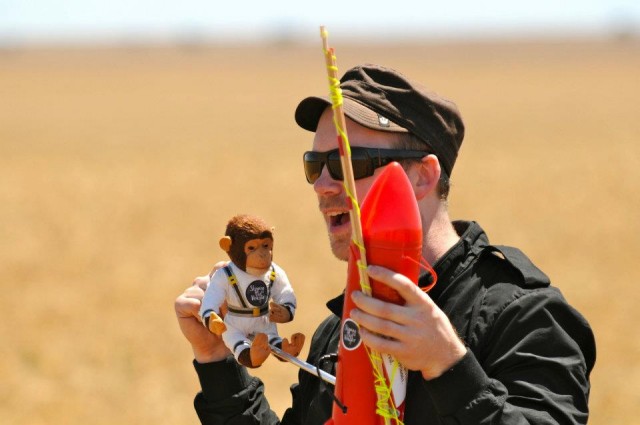Launch in Bendigo this weekend
Andrew wrote in to let us know that there will be a launch taking place in Bendigo this weekend (Saturday the 6th of July):
Hi all,
FYI, our project team is planning to release a high altitude balloon from Bendigo this coming Saturday 6th July 2013 at 11am.
We will have an onboard camera sending images back via SSDV (http://ukhas.org.uk/guides:ssdv), which is basically broken up JPEG with some extra headers.
RTTY will be used for radio transmission.
We do not expect to recover the balloon, and will appreciate any assistance with getting data from the payload along the path, in Victoria, Southern NSW, ACT, and Tas. See attached expected path.
All you need is a radio capable of receiving SSB at 434.650MHz, and a Mac/Windows/Linux computer with sound card input and access to the internet. High gain antenna is highly desirable.
See instructions here: http://projectspaceballoon.net/ssd/
The other details are:
- Frequency 434.650Mhz (+-10Khz), USB
- RTTY with 460Hz shift, 300 baud, 8 bit ASCII, no parity, one stop bit.
- Hardware is a Rev A Raspberry Pi, with a 25mW UHF transmitter module.
- Antenna is a quarter-wave with radials.
- Expected "cruising" altitude is 20km.
You will be able to see the images on your computer if you can receive the RF signal directly.
If internet access is available the images can be uploaded to the internet for others to view.
Tracking (from distributed listeners like yourselves) will be available at http://spacenear.us/tracker Images will be available at http://ssdv.habhub.org
The call sign for tracking and SSDV is PSBPI.
We plan to have someone in #highaltitude chatroom on irc.freenode.net on the day to co-ordinate.
Thanks in advance for your help.
Regards.
Andy VK3YT
A successful weekend of launches
We're happy to report that both launches this weekend (Horus 26 & 27) were a success.
Many thanks to everybody who turned out at the WIA AGM to hear our talk and witness the launches, and an extra thanks to everybody who helped make this weekend possible.
Keep an eye on the blog over the coming days for full details of the launches including photos & videos of the day.
WIA Launch Frequencies
Tomorrow the 27th of May we will be launching two balloons from Mildura, Victoria.
Data from the telemetry payloads can be demodulated using the dl-fldigi software, available by clicking the tracking link above.
All those wishing to track should take note of the following frequencies:
Horus 26 - WIA Repeater Launch - 0800 AEST
- Telemetry: 434.075MHz USB 300baud RTTY 7N1 (Select "HORUS" from dl-fldigi's dropdown list.
- APRS: 145.175MHz AFSK using callsign VK5ARG-11
- Cross-band Repeater:
- Uplink 438.900MHz FM 123Hz CTCSS. Please use the CTCSS tone, or else you will only be causing interference to other repeater users.
- Downlink: 147.500MHz FM.
The repeater will have net control run by VK3WIA.
Horus 27 - Imaging Payload - 0900 AEST
- Telemetry: 434.650MHz USB 300baud RTTY 7N1 (Select "DARKSIDE" from list)
- APRS: 145.175MHz AFSK using callsign VK5ARG-12
Between-car comms frequencies
We will primarily be using the airborne repeater for comms, and as such, the following callsigns should be given priority on the repeater:
- VK5ZM
- VK5GR
- VK5QI
- VK5VZI
For close range comms we will be using 146.550MHz FM simplex.
Long-range HF comms frequencies are 3640KHz LSB and 7070KHz LSB.
The WIA Annual General Meeting Voice Repeater Flight This Sunday
Several months ago, the Project Horus group was invited to participate in the Wireless Institute of Australia's Annual General Meeting and Technical Symposium presentations, being held in Mildura, Victoria over the weekend of Friday May 25th to Sunday May 27th. The group happily accepted, and is now in the final stages of preparation for what will be a very busy weekend for us.
Firstly, the Project Horus group will be giving a technical presentation on Saturday afternoon as part of the AGM technical sessions. During our 40 minute presentation we will be giving an introduction to the project and highlighting some of the amateur radio aspects of the project's operations. You can find out more about the Technical Symposium and other AGM activities on the WIA's website: https://www.wia.org.au/joinwia/wia/2012agm/
The main event for us, however, begins on Sunday with the launch campaign planned from Mildura.
Flight #1 - HORUS 26 - Amateur Radio Repeater - Sunday May 27th
The first balloon that will be launched at the convention is going to carry aloft the flying cross-band FM voice repeater. This repeater will be accessible at apogee from nearly 2,000,000 sq km of SE Australia and is expected to cover Sydney, Melbourne, Canberra and Adelaide simultaneously.
Horus 26 should lift off at approximately 8am AEST Sunday May 27th. (2200 UTC May 26th).
The window for contacts covering that footprint will only be ~30-60 minutes at apogee which should be reached at approximately the 90-120 minute mark in the flight. In all, 2,000,000 sqkm of SE Australia will be able to see the balloon repeater as the footprint will extend to approximately a 1600km diameter.
The FM cross band voice repeater frequencies on the balloon for this flight are:
- 438.900 MHz Uplink with 123Hz CTCSS (FM)
- 147.500 MHz Downlink (FM)
Net control will be a joint effort between our usual net controller in Adelaide (VK5GH) and a local net control operator based out of Mildura (to cover the flight until it can be heard in Adelaide).В Contacts will be logged and QSL cards will be provided for all contacts via the HORUS balloon repeater.
Horus 26 Telemetry Sources
In addition to the voice repeater, amateurs will be able to follow the flight via the APRS network on 145.175MHz. VK5ARG-11 will be beaconing the balloons position throughout the flight via a “WIDE2-1” beacon path. This will enable it to be picked up by iGATE systems across SE Australia and then be relayed to the Internet. Amateurs will be able to watch the balloons progress via popular APRS sites such as http://www.aprs.fi/
To provide the ground crews with some systems redundancy, the standard RTTY 300 baud telemetry payload will also be flying. This beacon can be received and decoded with the DL-FLDIGI software. You can find out more about how to decode this beacon here: http://projecthorus.org/?page_id=336
This 300baud RTTY telemetry beacon will fly on 434.075MHz ± 5kHz USB (the beacon drifts as the payload gets cold – it can reach below -50dec C during the flight in the payloads). This flight will identify on the air as HORUS.
The project group is very keen for amateurs within the footprint to also attempt to receive this beacon, as the data collected is (when you enable the Internet option in the software) also uploaded to the http://spacenear.us/tracker/ website. There it is aggregated and used to help predict the landing zone of the balloon during flight. As such, it is a valuable resource for the chase teams, and is a great way for the amateur radio community to get involved in the engineering side of the flight.
Flight #2 – HORUS 27 – Imaging Payload
The Project Horus group has carried a number of imaging payloads aloft over its more than 2 year history. We have had one of these payloads waiting for the right weather conditions for some time now. The legendary sunny weather of Mildura and reduced risks of landing in the ocean has given the team the inspiration to attempt to fly this imaging payload as well this weekend. As a result, Horus 27 is also planned to fly THIS SUNDAY.
Horus 27 will also carry an APRS and RTTY telemetry system.
APRS will operate as VK5ARG-12 on 145.175MHz operating in the same way as VK5ARG-11.
The 300 Baud RTTY will operate on 434.650 MHz ± 5kHz USB. HORUS 27’s RTTY telemetry will identify as DARKSIDE to separate the telemetry streams when they are uploaded to http://spacenear.us/tracker/ .
The Horus 27 flight is currently planned to lift off at ~0900Hrs Sunday 27th May (2300 UTC May 26th).
Amateurs are invited to also track HORUS 27 and provide their received telemetry feed via the Internet to the SpaceNear website. The project team would really appreciate seeing telemetry from both balloons (which will both be in the air simultaneously) being captured by amateurs from around SE Australia as it all helps capture as much data as possible about the progress of the flight.
For confirmation of launch of each balloon, the team will post announcements to the VKLOGGER DX Cluster as well as progress updates via Twitter (look for hash tag #projecthorus).
We look forward to seeing amateurs from across the region get involved in tracking and communicating via this unique experimental system!
Best Regards,
The Project Horus Balloon Team
Writeups videos for Horus 22 + Horus 23 online
The writeups for Horus 22 and Horus 23 are now online.
Grant has put together a couple of great videos on the last 2 launches - be sure to check out all his work on his Project Horus Vimeo channel.
A big thanks to all who helped make Horus 23 such a success!
Horus 23 WIA National Field Day Launch
This weekend, on Sunday the 15th of April, Project Horus will be partaking in the WIA National Field DayВ by launching Horus 23. We hope to be launching around 11AM, right after the WIA Sunday morning broadcast. This launch will be flying 3 payloads of interest to amateur radio operators:
- A FM voice repeater. This repeater will be operating with a 70cm uplink and a 2m downlink. Experience from flying this repeater in the past has shown that it can be accessed from up to 800km away at apogee with about 30-50W. Operators closer to the launch site should be able to access the repeater using a simple handheld, though a beam will help overcome the FM capture effect. The Amateur Radio Experimenters Group (AREG)В will be running net control on the voice repeater as VK5ARG, from the launch site in the Adelaide Hills.
- APRS on 145.175MHz. We're expecting to be using VK5ARG-11 as the call-sign. This will be visible on aprs.fiВ and will showcase their new horizon ring service. We will also be broadcasting telemetry via APRS.
- The ever-reliable 300-baud RTTY downlink will also be flying. This will likely be operating on 434.075MHZ (+-5KHz due to thermal drift). Instructions on how to track this can, as always, be found here. This payload will be trackable on the SpaceNear.us tracker.
This flight will also be testing the new uplink & cutdown system. This is a new design allowing us to terminate flights in the case of floats, or other un-foreseenВ circumstances. This experiment is intended to give us an idea of RF noise floor levels while at high altitudes, and work out what power levels are required for a successful uplink. The status of the uplink system should be visible on the SpaceNear.us tracker during the flight.
As always, launch is very much subject to weather, and final confirmation of the launch won't be given until Sunday morning. We will continue to update this blog as new information becomes available.
UPDATE: The cross-band voice repeater will be running with a 144.650MHz downlink, a 438.9MHz uplink, with a 123Hz CTCSS access tone.
Horus 22 flies tomorrow, flight reports for 20 21 online
This Wednesday, the 14th of March around 9am, we'll be launching Horus 22. We'll be running the standard 300 baud RTTY telemetry (434.650MHz) and APRS (145.175MHz). Tracking instructions are, as always, available here.
Thanks to the hard work of Mark, the launch info pages for Horus 20В and Horus 21 (the two Linux.conf.au launches) are now (finally) up! Go take a look and see what we did while in Ballarat.
Project Horus balloon launch at LCA 2012
On Tuesday the 17th ofВ January, we gave our presentation on high altitude ballooning at the 2012 Linux.conf.au, following up with the launch a micropayload. A big thanks to everyone who turned out for the talk and came along to the launch!
We certainly weren't short on volunteers with cameras at the launch - many thanks to those of you who got us coverage via the likes of Gizmodo.
Unfortunately the balloon did end up getting quite a bit higher (and hence further away!) than we had expected - it eventually landed out in Port Phillip bay. For the curious folk, there is a KML of the flight path online here.
Mark managed to do an excellent job of decoding the payload right down to the ground - despite being over 50km away, we managed to receive data right down to 83m above sea level.
The video highlights reel we showcased at the conference is nowВ publiclyВ available - a big thanks to our resident video guru Grant.
For those who saw the talk, don't forget that voting is still open for the best talks of LCA 2012. The most highly rated talks will be repeated on Friday the 20th - given the opportunity we'll be launching and tracking another micropayload. ![]()
Horus 19 writeup online
The full Horus 19 writeup is now online. However, we've not yet published any footage of Baker's ride to the edge of space - stay tuned, we'll be publishing that shortly. ![]()
Grant also put together a great behind the scenes video of Horus 19 - thanks Grant! For loads more Project Horus videos, check out Grant's Vimeo profile.
Horus 19: a great success!
We successfully launched & recovered Horus 19 this morning - with perfect weather conditions, it was a great day.
Skipping Girl Vinegar came along for the chase, recovering the payload with us just outside of Tailem Bend after a ~3 hour flight.
Many thanks to everyone who helped make today go so smoothly - fullВ write-upВ including pics & video very soon! ![]()
